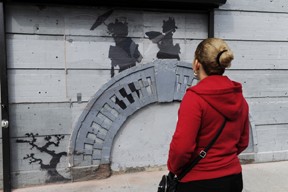
The anonymous British graffiti artist Banksy just concluded a month-long residency spray-painting his way through New York City’s five boroughs aptly-titled “Better Out Than In.” The age-old graffiti debate has emerged once again, and it seems like billionaire-mayor Michael Bloomberg needs to walk out of the art museum he just bought, into the streets to smell the spray-paint.
New Yorkers watched transfixed as the clever artist dodged the NYPD at every twist and turn. Banksy posted a picture of a new work every day on his website and then people flocked to find each day’s piece. On day 23, Oct. 23, his website declared “Today’s art has been canceled due to police activity.” Mayor Bloomberg, known for his wars on soft drinks and public smoking, decried the artwork as destruction of property and saying it was not art.
Bloomberg was wrong: graffiti is art. Anything can be art, and maybe not all graffiti is art, but Banksy is not some low-level gang member tagging walls. One only needs look at the responses of the property owners where Banksy deposited his artwork. They rushed to put up coverings to protect these new treasures, while others decided to dismantle them and then auction them off. Past works often have gone for hundreds of thousands of dollars at auctions.
Before his residency, Banksy had a cult-like following in the U.S. After, Banksy is the best-known contemporary artist, save Thomas Kinkade.
Part of this is because his artwork is so accessible; it’s not in the stuffy, intimidating museums that characterize the traditional art world, but rather in the streets. You might liken his work to a YouTube flash mob. The work itself lasts for a very short time, but goes “viral” soon after, achieving instant notoriety even after it’s long gone.
Second, is that the artwork itself is easy to understand. On Oct. 11, “Silence of the Lambs,” a truck loaded full of screaming lamb puppets driving through the meatpacking district, was a jab at factory farming. On Oct. 27, his mock New York Times op-ed calling the partially-completed Freedom Tower a “shyscraper” was a call for New York to return to its pre-9/11 boldness.
You could say that Banksy is democratizing art because people who traditionally don’t follow art and don’t have much of an interest in it are now following Banksy.
There is no need for professional art critics to tell us the meaning of Banky’s art; this is no modern art.
Hebron is a sophomore majoring in journalism and human rights.








